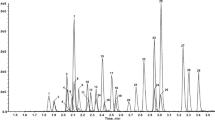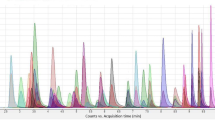Abstract
A simple procedure has been developed and validated for the qualitative and quantitative analysis of several opiates (morphine, 6-acetylmorphine, codeine, 6-acetylcodeine) and tramadol in hair. The analytes were extracted from within the matrix via an overnight incubation with methanol at 65 °C, and afterwards the samples were cleaned up by mixed-mode solid-phase extraction. The extracts were derivatized with N-methyl-N-(trimethylsilyl) trifluoroacetamide with 5% trimethylchlorosilane and analyzed by gas chromatography–mass spectrometry in the selected ion monitoring mode. The method was linear from 0.05 (lower limit of quantitation) to 50 ng/mg (40 ng/mg for tramadol), with correlation coefficients higher than 0.99 for all compounds, accomplishing the cut-off values proposed by the Society of Hair Testing for the detection of these substances in hair (0.2 ng/mg). Intra- and interday precision and trueness were in conformity with the criteria normally accepted in bioanalytical method validation, and the sample cleanup step presented a mean efficiency higher than 90% for all analytes. Furthermore, using these incubation conditions, 6-acetylmorphine did not significantly hydrolyze to morphine. For these reasons, and because of its simplicity, the proposed method can be successfully applied in the determination of these compounds in hair samples, and is suitable for application in routine analysis with forensic purposes.



Similar content being viewed by others
References
Bush DM (2008) The U.S. Mandatory Guidelines for Federal Workplace Drug Testing Programs: current status and future considerations. Forensic Sci Int 174:111–119
Tsanaclis L, Wicks JF (2007) Patterns in drug use in the United Kingdom as revealed through analysis of hair in a large population sample. Forensic Sci Int 170:121–128
Kintz P, Villain M, Dumestre V, Cirimele V (2005) Evidence of addiction by anesthesiologists as documented by hair analysis. Forensic Sci Int 153:81–84
Cairns T, Hill V, Schaffer M, Thistle W (2004) Levels of cocaine and its metabolites in washed hair of demonstrated cocaine users and workplace subjects. Forensic Sci Int 145:175–181
Cairns T, Hill V, Schaffer M, Thistle W (2004) Amphetamines in washed hair of demonstrated users and workplace subjects. Forensic Sci Int 145:137–142
Gallardo E, Barroso M, Queiroz JA (2009) LC-MS: a powerful tool in workplace drug testing. Drug Test Analysis 1:109–115
Cone EJ (2001) Legal, workplace, and treatment drug testing with alternate biological matrices on a global scale. Forensic Sci Int 121:7–15
Gallardo E, Queiroz JA (2008) The role of alternative specimens in toxicological analysis. Biomed Chromatogr 22:795–821
Caplan YH, Goldberger BA (2001) Alternative specimens for workplace drug testing. J Anal Toxicol 25:396–369
Kintz P, Villain M, Cirimele V (2008) Chemical abuse in the elderly: evidence from hair analysis. Ther Drug Monit 30:207–211
Rossi R, Lancia M, Gambelunghe C, Oliva A, Fucci N (2009) Identification of GHB and morphine in hair in a case of drug-facilitated sexual assault. Forensic Sci Int 186:e9–e11
LeBeau MA (2008) Guidance for improved detection of drugs used to facilitate crimes. Ther Drug Monit 30:229–233
Kintz P (2007) Bioanalytical procedures for detection of chemical agents in hair in the case of drug-facilitated crimes. Anal Bioanal Chem 388:1467–1474
Negrusz A, Gaensslen RE (2003) Analytical developments in toxicological investigation of drug-facilitated sexual assault. Anal Bioanal Chem 376:1192–1197
Lozano J, García-Algar O, Vall O, de la Torre R, Scaravelli G, Pichini S (2007) Biological matrices for the evaluation of in utero exposure to drugs of abuse. Ther Drug Monit 29:711–734
Gray T, Huestis M (2007) Bioanalytical procedures for monitoring in utero drug exposure. Anal Bioanal Chem 388:1455–1465
Kintz P, Villain M, Cirimele V (2006) Hair analysis for drug detection. Ther Drug Monit 28:442–446
Kintz P, Samyn N (2002) Use of alternative specimens: drugs of abuse in saliva and doping agents in hair. Ther Drug Monit 24:239–246
Bresson M, Cirimele V, Villain M, Kintz P (2006) Doping control for metandienone using hair analyzed by gas chromatography-tandem mass spectrometry. J Chromatogr B 836:124–128
Dumestre-Toulet V, Cirimele V, Ludes B, Gromb S, Kintz P (2002) Hair analysis of seven bodybuilders for anabolic steroids, ephedrine, and clenbuterol. J Forensic Sci 47:211–214
Frison G, Favretto D, Vogliardi S, Terranova C, Ferrara SD (2008) Quantification of citalopram or escitalopram and their demethylated metabolites in neonatal hair samples by liquid chromatography-tandem mass spectrometry. Ther Drug Monit 30:467–473
Florescu A, Ferrence R, Einarson T, Selby P, Soldin O, Koren G (2009) Methods for quantification of exposure to cigarette smoking and environmental tobacco smoke: focus on developmental toxicology. Ther Drug Monit 31:14–30
Pelander A, Ristimaa J, Rasanen I, Vuori E, Ojanperä I (2008) Screening for basic drugs in hair of drug addicts by liquid chromatography/time-of-flight mass spectrometry. Ther Drug Monit 30:717–724
European Monitoring Centre for Drugs and Drug Addiction (2008) 2008 annual report on the state of drugs problem in Europe http://www.emcdda.europa.eu/publications/annual-report/2008. Accessed 21 Sept 2009.
Girod C, Staub C (2000) Analysis of drugs of abuse in hair by automated solid-phase extraction, GC/EI/MS and GC ion trap/CI/MS. Forensic Sci Int 107:261–271
Romano G, Barbera N, Spadaro G, Valenti V (2003) Determination of drugs of abuse in hair: evaluation of external heroin contamination and risk of false positives. Forensic Sci Int 131:98–102
Moore C, Feldman M, Harrison E, Rana S, Coulter C, Kuntz D, Agrawal A, Vincent M, Soares J (2006) Disposition of hydrocodone in hair. J Anal Toxicol 30:53–359
Cordero R, Paterson S (2007) Simultaneous quantification of opiates, amphetamines, cocaine and metabolites and diazepam and metabolite in a single hair sample using GC-MS. J Chromatogr B 850:423–431
Skender L, Karacić V, Brcić I, Bagarić A (2002) Quantitative determination of amphetamines, cocaine, and opiates in human hair by gas chromatography/mass spectrometry. Forensic Sci Int 125:120–126
Gambelunghe C, Rossi R, Ferranti C, Rossi R, Bacci M (2005) Hair analysis by GC/MS/MS to verify abuse of drugs. J Appl Toxicol 25:205–211
Scheidweiler KB, Cone EJ, Moolchan ET, Huestis MA (2005) Dose-related distribution of codeine, cocaine, and metabolites into human hair following controlled oral codeine and subcutaneous cocaine administration. J Pharmacol Exp Ther 313:909–915
Kłys M, Rojek S, Kulikowska J, Bozek E, Scisłowski M (2007) Usefulness of multi-parameter opiates-amphetamines-cocainics analysis in hair of drug users for the evaluation of an abuse profile by means of LC-APCI-MS-MS. J Chromatogr B 854:299–307
Pragst F, Baliková MA (2006) State of the art in hair analysis for detection of drug and alcohol abuse. Clin Chim Acta 370:17–49
Kintz P, Jamey C, Cirimele V, Brenneisen R, Ludes B (1998) Evaluation of acetylcodeine as a specific marker of illicit heroin in human hair. J Anal Toxicol 22:425–429
Hadidi KA, Almasad JK, Al-Nsour T, Abu-Ragheib S (2003) Determination of tramadol in hair using solid phase extraction and GC-MS. Forensic Sci Int 135:129–136
de Lima EC, da Silva CL, Gauchée ML, Tavares MF (2003) Critical comparison of extraction procedures for the capillary electrophoretic analysis of opiates in hair. J Capill Electrophor Microchip Technol 8:111–116
Moore C, Marinetti L, Coulter C, Crompton K (2008) Analysis of pain management drugs, specifically fentanyl, in hair: application to forensic specimens. Forensic Sci Int 176:47–50
Balíková MA, Habrdová V (2003) Hair analysis for opiates: evaluation of washing and incubation procedures. J Chromatogr B 789:93–100
Wu YH, Lin KL, Chen SC, Chang YZ (2008) Simultaneous quantitative determination of amphetamines, ketamine, opiates and metabolites in human hair by gas chromatography-mass spectrometry. Rapid Commun Mass Spectrom 22:887–897
Musshoff F, Lachenmeier K, Wollersen H, Lichtermann D, Madea B (2005) Opiate concentrations in hair from subjects in a controlled heroin-maintenance program and from opiate-associated fatalities. J Anal Toxicol 29:345–352
Lachenmeier K, Musshoff F, Madea B (2006) Determination of opiates and cocaine in hair using automated enzyme immunoassay screening methodologies followed by gas chromatographic-mass spectrometric (GC-MS) confirmation. Forensic Sci Int 159:189–199
WADA – World Anti-Doping Agency (2004) nternational Standard for Laboratories. Identification criteria for qualitative assays incorporating chromatography and mass spectrometry. 2004, URL: http://www.wada-ama.org/rtecontent/document/criteria_1_2.pdf. Accessed 19 May 2009.
Barroso M, Dias M, Vieira DN, Queiroz JA, López-Rivadulla M (2008) Development and validation of an analytical method for the simultaneous determination of cocaine and its main metabolite, benzoylecgonine, in human hair by gas chromatography/mass spectrometry. Rapid Commun Mass Spectrom 22:3320–3326
Musshoff F, Madea B (2007) Analytical pitfalls in hair testing. Anal Bioanal Chem 388:1475–1494
Hoelzle C, Scheufler F, Uhl M, Sachs H, Thieme D (2008) Application of discriminant analysis to differentiate between incorporation of cocaine and its congeners into hair and contamination. Forensic Sci Int 176:13–18
Society of Hair Testing (2004) Recommendations for hair testing in forensic cases. Forensic Sci Int 145:83–84
Polettini A, Stramesi C, Vignali C, Montagna M (1997) Determination of opiates in hair. Effects of extraction methods on recovery and on stability of analytes. Forensic Sci Int 84:259–269
Food and Drug Administration: U.S. Department of Health and Human Services (2001) Guidance for Industry, Bioanalytical Method Validation. FDA http://www.fda.gov/downloads/Drugs/GuidanceComplianceRegulatoryInformation/Guidances/UCM070107.pdf. Accessed 19 May 2009.
International Conference on Harmonization (ICH) (2005) Validation of Analytical Procedures: Methodology ICH Q2 B. ICH http://www.ich.org/LOB/media/MEDIA417.pdf. Accessed 19 May 2009.
Musshoff F, Madea B (2007) New trends in hair analysis and scientific demands on validation and technical notes. Forensic Sci Int 165:204–215
Kintz P, Bundeli P, Brenneisen R, Ludes B (1998) Dose-concentration relationships in hair from subjects in a controlled heroin-maintenance program. J Anal Toxicol 22:231–236
Kronstrand R, Nÿstrom I, Strandberg K, Druid H (2004) Screening for drugs of abuse in hair with ion spray LC-MS-MS. Forensic Sci Int 145:183–190
Musshoff F, Lachenmeier K, Lichtermann D, Madea B (2009) Cocaine and opiate concentrations in hair from subjects in a heroin maintenance program in comparison to a methadone substituted group. Int J Legal Med 123:363–369
Sabzevari O, Abdi Kh, Amini A, Shafiee A (2004) Application of a simple and sensitive GC-MS method for determination of morphine in the hair of opium abusers. Anal Bioanal Chem 379:120–124
Hegstad S, Khiabani HZ, Kristoffersen L, Kunøe N, Lobmaier PP, Christophersen AS (2008) Drug screening of hair by liquid chromatography-tandem mass spectrometry. J Anal Toxicol 32:364–372
Miller EI, Wylie FM, Oliver JS (2008) Simultaneous detection and quantification of amphetamines, diazepam and its metabolites, cocaine and its metabolites, and opiates in hair by LC-ESI-MS-MS using a single extraction method. J Anal Toxicol 32:457–469
Author information
Authors and Affiliations
Corresponding author
Rights and permissions
About this article
Cite this article
Barroso, M., Dias, M., Vieira, D.N. et al. Simultaneous quantitation of morphine, 6-acetylmorphine, codeine, 6-acetylcodeine and tramadol in hair using mixed-mode solid-phase extraction and gas chromatography–mass spectrometry. Anal Bioanal Chem 396, 3059–3069 (2010). https://doi.org/10.1007/s00216-010-3499-9
Received:
Revised:
Accepted:
Published:
Issue Date:
DOI: https://doi.org/10.1007/s00216-010-3499-9




